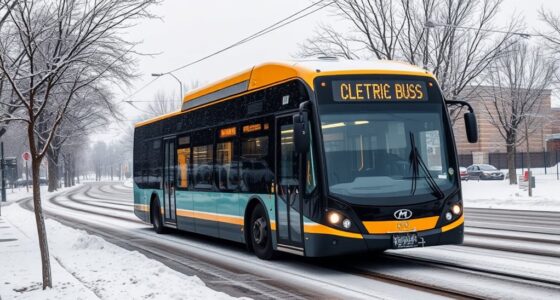When you ride an electric bus for the first time, you’ll notice how quiet and smooth it feels compared to traditional buses. The near-silent operation, quick acceleration, and absence of engine noise create a calming atmosphere. Many new riders highlight how modern and environmentally friendly the experience is. If you keep exploring, you’ll discover more about how these buses fit into daily transit and the advancements making them more practical for everyone.
Key Takeaways
- Riders often notice the quiet, smooth, and modern ride compared to traditional diesel buses.
- Many are impressed by the near-silent operation and quick acceleration from stops.
- First-time riders frequently comment on the environmentally friendly aspect and reduced noise pollution.
- Experiences highlight the importance of charging infrastructure and battery range for daily use.
- New riders are generally excited about the technological advancements and future potential of electric buses.

Have you ever wondered what it’s like to ride an electric bus for the first time? Stepping onto one of these modern vehicles, you might notice how quiet and smooth the ride feels compared to traditional buses. Electric buses are known for their near-silent operation, which creates a more comfortable experience for passengers. But as a first-time rider, your curiosity will likely focus on how the bus manages its power, especially since battery range and charging infrastructure are essential factors in their operation.
Experiencing a quiet, smooth ride on an electric bus highlights the importance of battery range and charging infrastructure.
The battery range of an electric bus determines how far it can go before needing a recharge. Many new riders are surprised to learn that modern electric buses can typically cover 150 to 250 miles on a single charge, depending on the model and operating conditions. This range is usually sufficient for daily routes, especially when routes are planned efficiently around charging schedules. Still, it’s natural to wonder what happens if the battery runs low during a trip. Most transit systems have established robust charging infrastructure—quick chargers and depot stations—that guarantee buses are recharged overnight or during scheduled breaks. This setup minimizes downtime and keeps the fleet running smoothly.
When you first board an electric bus, you might notice the charging stations at the depot or along certain routes. These stations are designed to make recharging quick and easy, with some systems capable of adding significant range in just 30 minutes. This means buses can be charged during short layovers, making the entire operation more efficient. As a rider, you may not see the entire charging process, but knowing that the infrastructure is well-developed can reassure you that these buses are prepared for daily use. It’s a big step forward from earlier electric vehicle models where limited range and scarce charging options made long routes seem impractical.
Your first ride might also include a bit of awe at how quickly electric buses accelerate from stops, thanks to instant torque from their electric motors. The absence of engine noise and vibrations adds to the serenity of the ride. As you settle in, you realize that the combination of battery technology and robust charging infrastructure makes electric buses not only environmentally friendly but also highly practical for urban transit. They’re designed to operate seamlessly within established networks, ensuring reliable service without the constant worries of running out of power mid-route.
In the end, your initial experience on an electric bus will likely leave you impressed by how far transit technology has come. The balance of battery range and charging infrastructure plays a vital role in making electric buses a practical, sustainable choice. As a rider, you’re part of a shift toward cleaner urban transportation, and that first ride might just inspire you to advocate for more electric options in your city.
Frequently Asked Questions
How Long Does It Take to Charge an Electric Bus Completely?
Charging time for an electric bus varies based on its battery capacity, but typically, it takes between 3 to 8 hours for a full charge. Fast chargers can reduce this to around 1-2 hours, especially for buses with smaller batteries. You should consider the bus’s battery capacity and the type of charger available, as these factors directly influence the charging time and your operational schedule.
Are Electric Buses More Expensive to Operate Than Diesel Buses?
You’ll find that electric buses are generally cheaper to operate than diesel buses when considering the cost comparison. You save on fuel costs because electric buses use electricity, which is often less expensive than diesel fuel. Plus, they require less maintenance, reducing overall expenses. While the upfront investment can be higher, the long-term fuel savings and lower maintenance costs make electric buses more economical over time.
What Maintenance Is Required for Electric Bus Batteries?
Your electric bus batteries require minimal maintenance to keep them running smoothly, making them more reliable than you might believe. You’ll need to regularly monitor battery health to maximize longevity and guarantee ideal performance. Keep an eye on the state of charge and maintain a robust charging infrastructure to support consistent operation. Periodic checks and proper charging practices extend battery life, so you can enjoy longer-lasting, eco-friendly rides without the fuss of traditional engine upkeep.
How Do Electric Buses Perform in Extreme Weather Conditions?
In extreme weather conditions, electric buses may experience some performance changes, but climate adaptation solutions help maintain efficiency. Cold temperatures can slow battery degradation, reducing range, while hot weather might increase cooling needs. You’ll notice some impact on battery performance, but modern thermal management systems help mitigate these effects. Overall, with proper climate adaptation, electric buses perform reliably even in severe weather, ensuring safe and efficient transportation year-round.
What Safety Features Are Included in Electric Buses?
You’ll find electric buses packed with safety features like collision avoidance systems, emergency brakes, and CCTV cameras, all designed to keep everyone safe. Charging stations are strategically placed for quick access, and the robust battery lifespan guarantees reliable performance. These buses are built to protect passengers and drivers alike, proving that even in a world of high tech, safety is no joke—just smart, silent, and sustainable.
Conclusion
As you step off the electric bus, you realize how quiet and smooth the ride was—like gliding through a still, sunlit forest instead of the usual roar of engines. The city’s noise fades behind you, replaced by a peaceful hum of innovation. Your first ride may have been brief, but it leaves a lasting impression—reminding you that even in bustling streets, change can be as gentle as a whisper, shaping a cleaner, calmer future.









